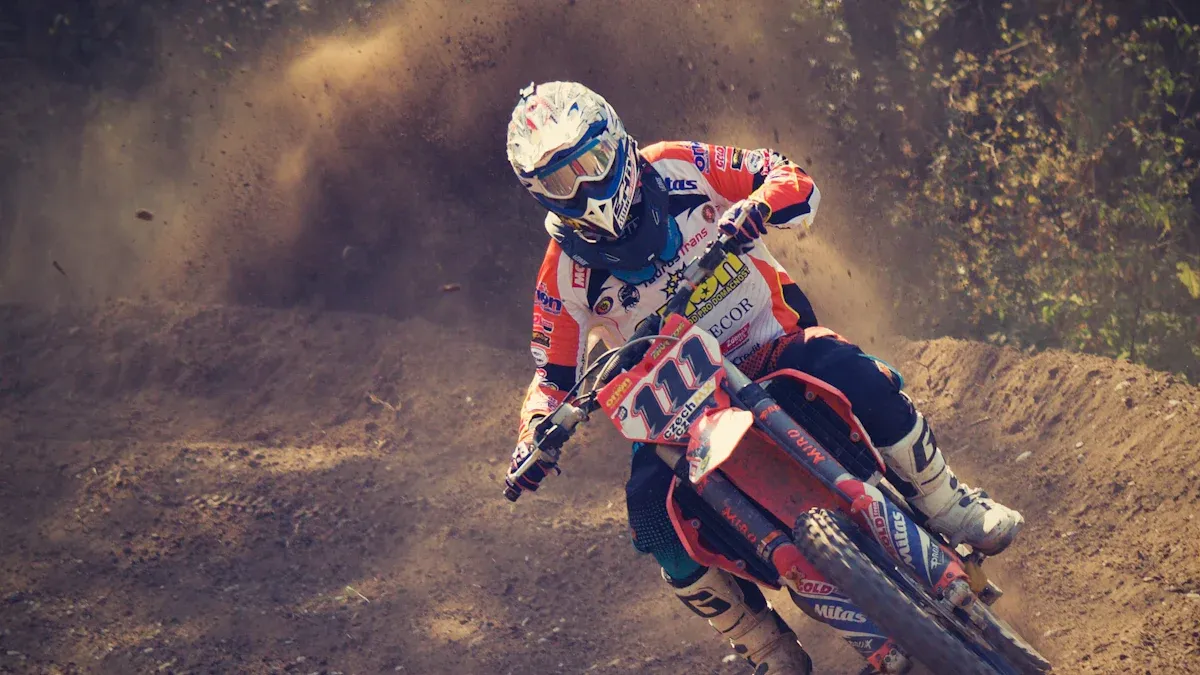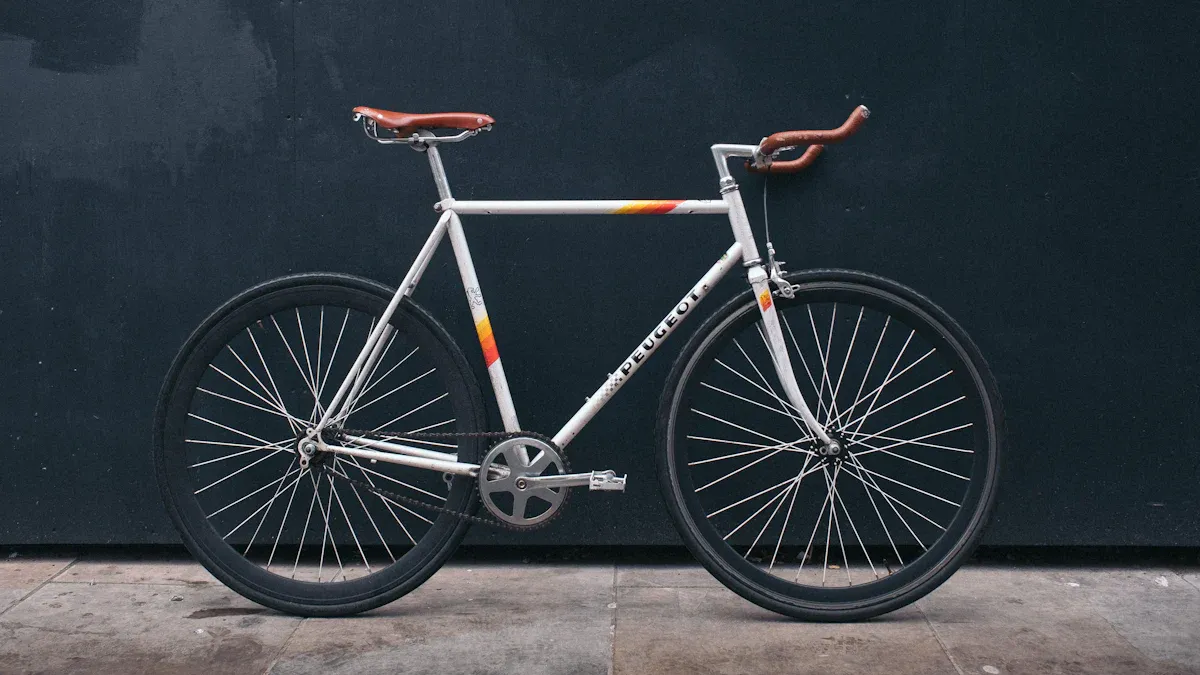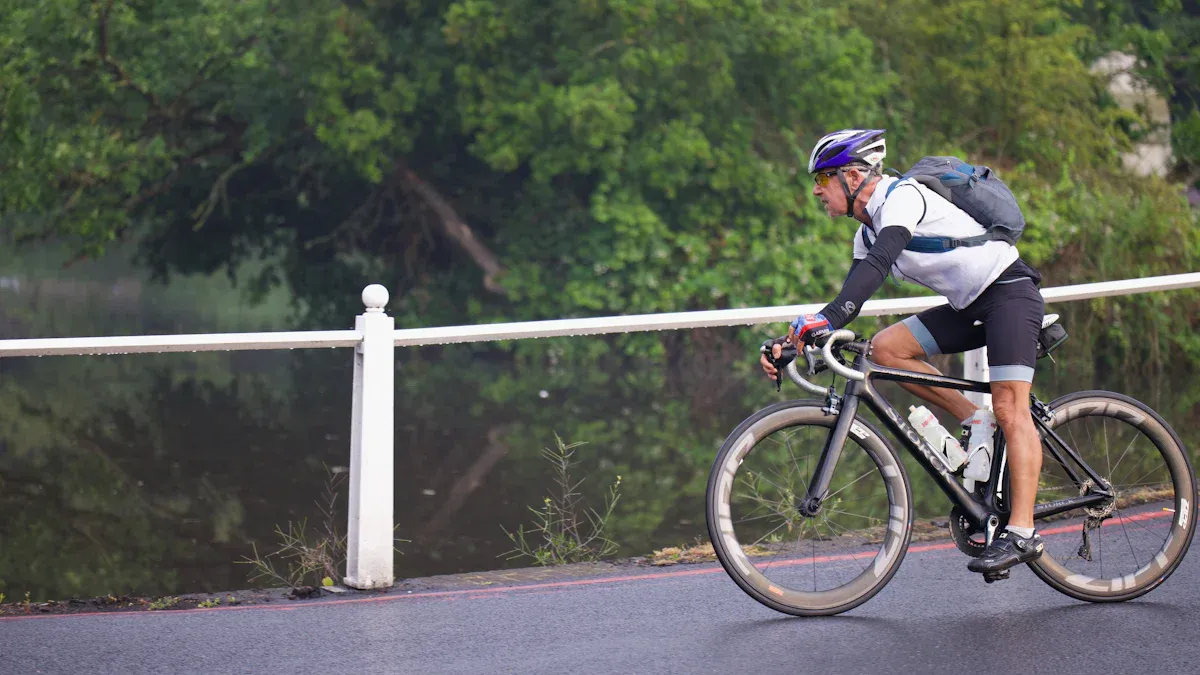
Choosing the right cyclocross bike frame can make a big difference in how you feel on every ride. You want a frame size that fits your body so you can ride with comfort and confidence. Start by measuring yourself, check a sizing chart, and look for good standover clearance. Cyclocross is all about quick moves and control, so a well-fitted cyclocross bike frame helps you stay safe and boost your confidence. With a few simple steps, you can enjoy cyclocross even more.
Key Takeaways
Measure your height and inseam with care. This helps you find a cyclocross bike frame that fits your body. Check the standover clearance for safety and comfort. You need 2 to 4 centimeters of space between your crotch and the top tube. Use sizing charts to help you start. Always test ride bikes to see what fits your body and riding style best. Adjust the saddle height and handlebar position. This can make you more comfortable and give you better control on rough cyclocross courses. If you feel pain or discomfort, think about getting a professional bike fit. This can help you set up your bike better and enjoy riding more.
Frame Size Basics

What Is Frame Size
When you look at bikes, you might notice numbers like 52cm or 54cm. These numbers show the frame size. For cyclocross bikes, frame size usually means the length of the seat tube. You measure this from the center of the bottom bracket (where the pedals spin) up to the top of the seat tube. Most brands use centimeters, but some use inches. Using centimeters helps you compare different bikes more easily.
You can measure your own frame size by first checking your inseam. Stand with your feet about shoulder-width apart and place a book between your legs, right up to your crotch. Measure from the ground to the top of the book. This number, in centimeters, helps you find the right frame size. Some people also look at reach and stack, which are the horizontal and vertical distances from the bottom bracket to the top of the head tube. These numbers help you get a better fit, but seat tube length is the main way to compare sizes.
Why Frame Size Matters
Getting the right frame size makes a huge difference in how you feel on your bike. If your bike is too big or too small, you might feel uncomfortable or even get hurt. A good fit helps you ride longer and with more control. Cyclocross bikes have a special shape that lets you steer quickly and move fast. If your frame size is wrong, you might feel off-balance or sore after riding.
A proper frame size keeps you comfortable and helps prevent injuries.
Small changes, like moving your saddle or handlebars, can make a big difference.
A well-fitted bike lets you ride with more confidence and control.
Tip: Many riders say that a cyclocross bike frame with the right size feels stable, even on rough descents. This stability comes from matching your body to the bike’s geometry.
If you want to enjoy cyclocross and stay safe, always pay attention to frame size. It’s the first step to a great ride.
Sizing a Bike for Cyclocross
Measuring Height and Inseam
When you start sizing a bike for cyclocross, you need to know your user height and inseam. These two numbers help you find a cyclocross bike frame that fits your body. To measure your height, stand straight against a wall with your shoes off. Use a book or ruler to mark the top of your head, then measure from the floor to the mark. Write down this number.
Next, measure your inseam. Stand with your back against the wall and your feet about shoulder-width apart. Place a large book between your legs, pressing it up to your crotch like a bike seat. Mark the top edge of the book on the wall. Measure from the floor to this mark. This is your inseam. Many riders use this number to compare with the seat tube length of a cross bike.
You can use your inseam to estimate the right frame size. Multiply your inseam by 0.666 to get a good starting point for the frame size in centimeters. For example, if your inseam is 80 cm, 80 x 0.666 = about 53 cm. This number helps you match your body to the cyclocross bike frame. Remember, cyclocross bikes often have a higher bottom bracket, so the effective top tube length can be just as important as the seat tube length. If you have long legs or a short torso, you might need to adjust your choice.
Tip: Always measure your inseam in stocking feet for the most accurate result. This method works for both men and women.
Standover Clearance
Standover height is another key part of finding the right fit for your cyclocross bike frame. Standover height means the distance from the ground to the top of the top tube, measured at the midpoint. When you stand over the bike, you want some space between your body and the top tube.
Cycling experts suggest you should have about 2 to 4 centimeters (1 to 2 inches) of clearance between your crotch and the top tube. This space helps you get on and off the bike quickly, which is important in cyclocross. You will often need to jump off your cross bike during a race or ride, so enough standover clearance keeps you safe and comfortable.
If you have less than 2 cm, you might hit the top tube when you dismount.
If you have more than 4 cm, the bike might be too small and affect your control.
Standover height is not the only thing to check, but it gives you a good starting point. Some riders with special body shapes or riding styles may need more or less clearance. Always try standing over the bike before you buy it.
Using Sizing Charts
Most bike brands offer sizing charts to help you pick the right cyclocross bike frame. These charts match your user height and inseam to a recommended frame size. You can usually find these charts on the brand’s website or in the bike shop. Here is an example of what a simple sizing chart might look like:
User Height (cm) | Inseam (cm) | Frame Size (cm) |
|---|---|---|
155-165 | 70-76 | 49-51 |
165-175 | 76-81 | 52-54 |
175-185 | 81-86 | 55-57 |
185-195 | 86-91 | 58-61 |
Sizing charts give you a starting point, but they are not perfect. Cyclocross bikes have different geometry than road or mountain bikes. The top tube and reach can feel different, even if the frame size is the same. If you fall between two sizes, most riders choose the smaller size for cyclocross. A smaller cross bike gives you better control and makes it easier to handle tight turns and quick moves.
Note: Sizing charts help you get close, but your comfort and riding style matter most. Always test ride a cyclocross bike frame if you can.
When you use your user height, inseam, and standover height together, you can find a cyclocross bike frame that fits well. Remember, the right fit helps you ride longer, safer, and with more confidence on every cross course.
Cyclocross Bike Frame Fit

Geometry Considerations
When you look at cyclocross bikes, you will notice that the frame geometry is different from road or mountain bikes. Geometry shapes how your bike feels and handles on cross courses. Here are some important geometry factors to keep in mind:
Head tube angle: A steeper angle gives you quick, sharp steering. A slacker angle makes the bike more stable at high speeds.
Seat tube angle: A steeper seat tube puts you forward for better power when you pedal. A slacker angle can feel more relaxed and comfortable.
Chainstay length: Shorter chainstays make your cyclocross bike feel more agile and help you speed up fast. Longer chainstays add stability and give you more room for wider tires.
Bottom bracket height: A higher bottom bracket helps you clear obstacles and pedal through rough ground, but it can make the bike feel less stable on descents.
You want a cyclocross bike that balances agility, control, and comfort. This balance helps you handle tight turns, hop barriers, and ride confidently on grass, mud, or sand.
Tip: Cyclocross geometry often means less comfort on long rides, but you gain speed and control on cross courses.
Top Tube and Reach
Top tube length and handlebar reach play a big role in your bike fit. Cyclocross bikes usually have a shorter top tube than road bikes. This design helps you ride in a more upright position, which is great for handling bumpy trails and jumping on and off your bike during a cross race.
Reach is the distance from the bottom bracket to the head tube. It affects how far you stretch to the handlebars. A shorter reach makes it easier to control your cyclocross bike, especially when you need to stand up or move quickly. You can fine-tune your fit by changing the stem length or handlebar type, but only a little. Most riders pick a top tube about 1 cm shorter than their road bike and use a shorter stem for better control.
Note: A good bike fit means you feel comfortable both sitting and standing, and you can handle your cross bike with confidence.
Comparing to Road and Mountain Bikes
Cyclocross bikes sit between road and mountain bikes in terms of geometry and fit. Road bikes have longer top tubes and a stretched-out position for speed on smooth roads. Mountain bikes have shorter frames and a more upright posture for control on rough trails. Cyclocross bikes mix these ideas. You get a sportier, more aggressive fit than a mountain bike, but you stay more upright than on a road bike.
Here’s a quick comparison:
Bike Type | Top Tube Length | Riding Position | Handling |
|---|---|---|---|
Road | Longer | Stretched | Stable, fast |
Cyclocross | Shorter | Upright | Quick, agile |
Mountain | Shortest | Most upright | Very maneuverable |
You can adjust your cyclocross bike fit with saddle height, stem length, and handlebar reach. These small changes help you get the best mix of comfort and control for cross riding. Remember, the right fit makes every cyclocross ride more fun and helps you perform your best on any cross course.
Achieving Proper Fit
Saddle Height and Setback
Getting your saddle height right is key for comfort and power. You want your saddle height about the same as your road bike, or just a bit lower—up to 1 cm. This helps you handle rough terrain and keeps your feet in a good position. When you pedal, your forefoot and heel should be level at the bottom of the stroke. If your saddle is too high, you might feel pain in the back of your knees or lower back. If it’s too low, you could get pain in the front of your knees.
Here’s a simple way to set your saddle height and saddle setback:
Start with your saddle level and centered on the rails.
Adjust the height so your knee angle is about 140-145 degrees at full extension.
Use the KOPS method for saddle setback: with your foot flat at the 3 o’clock position, the soft spot below your kneecap should be right over the pedal spindle.
Make small changes—no more than 1 cm at a time.
Ride a few times and check for pain. Keep fine-tuning until you feel good.
If you keep having pain, a professional bike fit can help you find the best setup for your body.
Studies show that the wrong saddle height can lower your power and raise your risk of knee injuries. A proper fit helps you ride stronger and safer.
Aspect | Impact of Improper Saddle Height | Implication for Cyclocross Cycling |
|---|---|---|
Power Output | Reduced due to closed hip angle and inefficient pedaling | Decreased cycling performance and anaerobic power |
Injury Risk | Increased knee joint strain and altered joint forces | Higher likelihood of knee injuries |
Bike Fit Importance | Proper saddle height and position relative to bottom bracket key | Optimizes power output and minimizes injury risk |
Handlebar Position
Handlebar position affects your control and comfort. You can adjust the height with headset spacers or change the stem angle. Most riders like a shoulder angle around 90 degrees or less for a more upright posture. Rotate your handlebars so your wrists feel neutral, not forced. Tilt your brake levers inward to ease hand pain and improve grip. Try different hand positions, including standing on the pedals, to see what feels best.
Wider handlebars give you more leverage and help you steer better on rough ground. If you race on twisty or technical courses, a wider bar can help you corner faster and stay stable over roots and rocks. Some sweep in the drops slows steering on loose surfaces and makes descents safer. Handlebar drop also affects your riding position, so pick what matches your style.
Don’t copy pro setups. Focus on your comfort and control. If you’re unsure, a bike fit expert can help you test stem length, angle, and handlebar drop.
Test Ride and Professional Bike Fit
Test riding is the best way to find your ideal fit. Sizing charts are helpful, but every brand and model feels different. Try several frame sizes to see which one gives you the best comfort, control, and quick dismounts. Adjust the saddle height and handlebar position during your test rides. Notice how each bike handles—smaller frames may feel more stable, while larger ones can be more agile.
If you still struggle to find a proper fit, consider a professional bike fit. Experts use special tools and watch your riding style to set up your bike for power, comfort, and safety. You’ll avoid injuries and enjoy cyclocross even more.
Picking the right cyclocross bike frame size helps you ride better. Use this simple checklist to help you:
Use your road bike frame size as a starting point, but check if the geometry is different.
Make sure your cyclocross frame has enough standover clearance and feels good when you carry it.
Change your saddle height and how far it sits back to get more power and control on cyclocross trails.
Move your handlebars up and make the reach shorter for easier handling.
Keep making small changes to your cyclocross setup after you buy it so you stay comfortable.
The right cyclocross fit helps stop injuries, makes you more comfortable, and lets you ride longer.
Special cyclocross changes help you stay safe when you do tricky moves or get off your bike.
Try out different cyclocross sizes or go to a fitting studio if you can. You will have more fun riding cyclocross when your bike fits you well!
FAQ
How do I know if my cyclocross bike frame is too big or too small?
If you struggle to reach the handlebars or feel stretched out, your frame might be too big. If you feel cramped or your knees hit the handlebars, it could be too small. Always check standover clearance.
Can I use my road bike size for a cyclocross bike?
You can use your road bike size as a starting point. Cyclocross bikes often feel better if you size down. Try both sizes if you can. Comfort and control matter most.
What if I fall between two frame sizes?
Most riders pick the smaller size for cyclocross. A smaller frame gives you better control and makes it easier to handle tight turns. Test ride both sizes if possible.
Do I need a professional bike fit?
A professional bike fit helps if you feel pain or can’t get comfortable. Fit experts adjust your bike for your body. You get more power, comfort, and safety. Many shops offer this service.
See Also
Understanding Large Mountain Bike Frame Sizes And Geometry
Complete Guide To Racing Bike Frame Sizes For Riders
Step By Step Guide To Accurate Bike Frame Sizing
